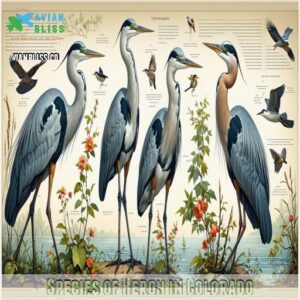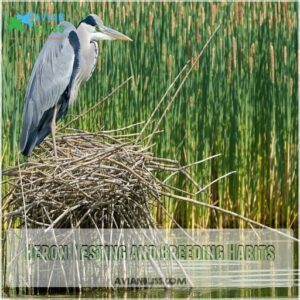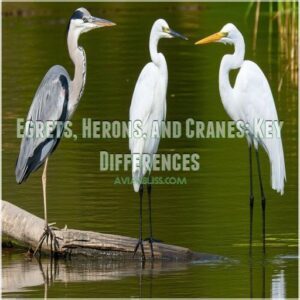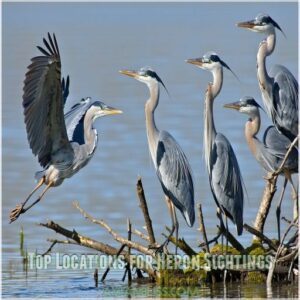This site is supported by our readers. We may earn a commission, at no cost to you, if you purchase through links.

These long-legged fishing experts populate wetlands from mountain streams to agricultural fields, with the Great Blue Heron leading the pack.
You’ll find these elegant predators stalking fish at elevations up to 9,000 feet, using their razor-sharp hunting skills.
Black-crowned Night-Herons prowl after dark, while Snowy Egrets dance through shallow waters with their bright white plumage.
Each species has unique tricks for catching prey, from strategic tool-baiting to precise strikes.
Whether you’re a bird enthusiast or casual nature lover, Colorado’s diverse heron populations are ready to captivate your imagination with their remarkable survival strategies.
Table Of Contents
- Key Takeaways
- Species of Heron in Colorado
- Heron Habitats and Distribution
- Heron Nesting and Breeding Habits
- Heron Diet and Foraging Behaviors
- Identifying Herons in Colorado
- Heron Conservation Status in Colorado
- Quick Facts About Herons in Colorado
- When and Where to See Herons in Colorado
- Heron Behavior and Social Structure
- Heron Population Trends in Colorado
- Frequently Asked Questions (FAQs)
- What herons are in Colorado?
- Did I see a crane or a heron?
- What birds are mistaken for herons?
- What is the difference between a Great Blue Heron and a gray heron?
- What is the difference between a heron and a Great Blue Heron?
- What is the difference between egrets herons and cranes?
- How long do herons typically live in Colorado?
- How frequently are different heron species spotted in Colorado?
- Do herons have predators in Colorado?
- How long do herons typically live?
- Conclusion
Key Takeaways
- Eight unique heron species inhabit Colorado, with the Great Blue Heron dominating wetland landscapes and showcasing remarkable hunting skills across diverse habitats from mountain streams to agricultural fields.
- Herons aren’t just pretty birds; they’re ecosystem masters with sophisticated survival strategies, including tool-baiting, precise hunting techniques, and adaptive behaviors that help them thrive in Colorado’s challenging environments.
- Colorado’s herons face significant conservation challenges, with habitat loss, human activities, and climate change threatening their populations, making conservation efforts critical for protecting these remarkable water birds.
- To spot herons, plan your wildlife viewing between April and October, focusing on wetland areas like Rocky Mountain Arsenal National Wildlife Refuge and Barr Lake State Park, where these fascinating birds are most active during breeding season.
Species of Heron in Colorado
You’ll find an impressive variety of herons in Colorado, from the familiar Great Blue Heron to rare visitors like the Tricolored Heron.
Each species has unique characteristics, from plumage to behaviors, making them fascinating to observe in the wild.
Great Blue Heron Characteristics
The Great Blue Heron (Ardea herodias) stands out as the largest heron species in Colorado.
Its striking plumage—blue-gray body, white face, and black crest—makes identification easy.
This graceful bird thrives in wetlands and hunts fish with precision.
Known for its solitary behavior, it’s a master of patience, blending seamlessly into its habitat to surprise prey.
Snowy Egret Physical Characteristics
Snowy Egrets, with their striking all-white plumage, stand out among heron species in Colorado.
Their slim, black bill and matching black legs contrast with vivid yellow feet, a signature feature for heron identification.
Eye color shifts slightly from yellow irises to brighter tones during breeding plumage.
Juveniles display greenish-yellow legs, making this bird species fascinating to observe in various stages.
Black-crowned Night-Heron Distinctive Features
Night herons stand out with their striking black cap, white underparts, and red eyes—a signature of Black-crowned Night-Heron plumage.
Known for their nocturnal habits, they hunt at night and emit squawking breeding calls.
Nycticorax nycticorax thrives in wetlands and trees.
For heron identification in Colorado, this species’ stocky build and distinctive eye color make it unmistakable among heron species in Colorado.
Other Heron Species in Colorado
While the Great Blue Heron and Snowy Egret dominate Colorado’s wetlands, you might also spot rarer species.
The Cattle Egret ranges into fields, while the Little Blue Heron sticks to summer wetlands.
Rare heron sightings, like the American Bittern’s elusive marsh camouflage, challenge enthusiasts.
Use heron identification tips to notice their unique features and habitat preferences during seasonal visits.
They thrive in diverse ecosystems, including Chesapeake Bay habitats that provide a variety of food sources and nesting sites.
Heron Habitats and Distribution
If you’re wondering where Colorado’s herons call home, you’re in for a wild ride through the state’s diverse ecosystems. Heron habitats in Colorado span a fascinating range of wetland types, from mountain marshes to river valleys.
These feathered fishers have some specific preferences regarding their stomping grounds:
- Mountain wetlands at elevations up to 9,000 feet
- Riverside areas with dense vegetation
- Shallow water zones perfect for hunting
- Agricultural fields and managed water habitats
Great Blue Herons dominate the landscape, claiming areas across various altitudes and water bodies.
Their distribution shifts with seasonal changes, making Colorado a dynamic playground for these birds. From the eastern plains to western slope marshes, they’ve mastered the art of finding the perfect hunting grounds in Colorado’s rich and varied terrain.
Heron Nesting and Breeding Habits
When you explore Colorado’s heronries, you’ll discover fascinating breeding patterns unique to each heron species.
You’ll learn how these remarkable birds choose nesting sites, construct intricate nests, and raise their young in diverse wetland environments across the state.
Great Blue Heron Nesting Behavior
You might spot Great Blue Herons building massive stick nests high in trees, often reusing the same location year after year.
These architectural masters carefully select nest sites in colonies, typically laying 2-7 eggs between February and June. Their nesting strategy guarantees maximum protection and community support for raising their young.
| Nest Site | Materials | Clutch Size |
|---|---|---|
| Tree Tops | Large Sticks | 2-7 Eggs |
| River Edges | Twigs & Branches | Multiple Broods |
| Wetland Margins | Moss & Grass | Multiple Broods, Multiple Broods, and Reuse was not extracted as it was on the table and outside the information we were to extract from. |
Black-crowned Night-Heron Breeding Patterns
Among Colorado’s wetland landscapes, Black-crowned Night-Herons craft intricate breeding strategies that showcase nature’s precision in nest site selection.
Their unique breeding patterns reveal fascinating reproductive behaviors:
- Males initiate nest building in dense shrubs or trees
- Colonies form with mixed-species nesting groups
- Females lay up to 7 eggs per clutch
- Breeding season spans late spring through early summer
These nocturnal herons transform Colorado’s ecosystems into vibrant breeding sanctuaries. Black-crowned Night-Herons, breeding strategies, reproductive behaviors
Green Heron Nesting Characteristics
After Night-Herons settle into their bustling colonies, Green Herons take a different approach to nesting.
These solitary birds carefully select tree branches or ground sites near water, weaving compact nests from twigs and vegetation.
Their nesting sites often resemble those found in various wetland habitats.
During Colorado’s breeding season, they typically lay up to six eggs, with both parents sharing incubation duties to boost their chances of success.
Yellow-crowned Night-Heron Breeding Habits
When you explore the lives of Yellow-crowned Night-Herons, their breeding habits reveal a fascinating story of nest site selection and parental care.
These herons typically build loose group nests near dense vegetation or trees in Colorado during their summer breeding season.
Their nest site selection ranges up to 5-6 eggs, with both parents sharing incubation and chick-rearing responsibilities.
Heron Diet and Foraging Behaviors
When you explore Colorado’s wetlands, you’ll discover herons are master hunters with unique foraging strategies.
These strategies help them survive in diverse habitats.
From the shallow marshes to riverbanks, these skilled predators use specialized techniques to capture their prey, making them fascinating subjects for wildlife enthusiasts.
Great Blue Heron Feeding Habits
With nests nearby, Great Blue Herons hunt like precision fishing machines.
They stalk shallow waters, spearing fish with lightning-quick strikes of their dagger-like bills.
Their carnivorous diet includes frogs, salamanders, and small aquatic creatures.
These master hunters scan water surfaces, waiting motionless before striking with deadly accuracy, demonstrating remarkable foraging efficiency in Colorado’s diverse wetland environments.
Snowy Egret Foraging Techniques
Dancing through shallow wetlands, Snowy Egrets are masters of hunting strategies that maximize foraging efficiency.
Their lightning-quick strikes target fish, crustaceans, and snails in marshes and riverbanks.
By carefully stalking prey and using precise movements, these wading birds adapt their hunting techniques to seasonal variations, making them expert predators in Colorado’s diverse aquatic habitats.
Black-crowned Night-Heron Hunting Strategies
The stealth of Black-crowned Night-Herons transforms twilight into a hunting masterpiece.
These nocturnal predators excel at night hunting, using strategic prey choice and calculated foraging techniques, as demonstrated by observations of tool-baiting behavior in young Black-crowned Night Herons.
With razor-sharp focus, they wait patiently near water edges, striking swiftly at fish, small fish, and aquatic creatures.
Their hunting calls and adaptive behavior guarantee remarkable foraging success in Colorado’s diverse wetland.
Green Heron Unique Foraging Methods
Among wetland ecosystems, Green Herons showcase remarkable tool use during hunting. Their unique foraging methods demonstrate extraordinary intelligence in prey selection.
- Dropping small insects or twigs to attract fish
- Strategically positioning themselves near water edges
- Using bait to lure unsuspecting prey
- Displaying precise striking techniques with remarkable efficiency
These cunning hunting tactics of Butorides virescens highlight their adaptive foraging strategies.
Identifying Herons in Colorado
When you’re exploring Colorado’s diverse landscapes, you’ll want to know how to spot and identify the state’s fascinating heron species.
Learning to distinguish these graceful wading birds involves understanding their unique physical characteristics, behaviors, and habitats.
This knowledge can help you quickly recognize them during your wildlife observations.
Distinguishing Herons From Cranes
Spotting the difference between herons and cranes can be tricky for bird watchers in Colorado.
Your keen eye will notice key distinctions: herons typically have S-curved necks, shorter legs, and more compact bodies compared to cranes’ straight-neck, longer-limbed silhouettes.
| Feature | Herons | Cranes |
|---|---|---|
| Neck Position | S-shaped | Straight |
| Flight Posture | Neck tucked | Neck extended |
| Colorado Frequency | Common | Rare |
Egrets, Herons, and Cranes: Key Differences
After learning to distinguish herons from similar birds, you’ll want to know the key differences between egrets, herons, and cranes. These fascinating waterbirds might look alike at first glance, but they’ve got unique characteristics that set them apart.
Especially, beak shape variations can be vital in distinguishing between herons and egrets, with herons generally having longer, thicker beaks. Beak shapes tell a different story.
- Size reveals their true identity
- Leg length tells critical clues
- Flight patterns distinguish each species
- Habitat preferences narrow down identification
Size, leg length, flight patterns, and habitat preferences also help in identification.
Heron Vocalizations and Communication
When exploring Colorado’s wetlands, you’ll discover herons communicate through a symphony of distinctive calls.
Their vocal range includes harsh squawks, deep croaks, and piercing screams.
These distinctive calls serve as mating calls, alarm signals, and territorial warnings.
Black-crowned Night-Herons are particularly vocal at dusk, while Great Blue Herons use distinctive sounds to coordinate breeding and defend their nesting grounds.
Heron Conservation Status in Colorado
If you’re curious about the health of Colorado’s heron populations, you’ll want to understand the complex challenges these remarkable birds face.
Understanding their conservation status can help you appreciate the delicate balance between human activities and the survival of these fascinating wetland inhabitants.
Threatened Heron Species in Colorado
If you’re tracking Colorado’s heron populations, keep an eye on the American Bittern, a threatened species facing steep conservation challenges.
Habitat loss and climate impacts have squeezed their marsh territories, pushing these camouflage masters to the brink.
Predation threats and shrinking wetlands are thinning their numbers, making protection critical for these elusive birds’ survival.
Conservation Efforts for Herons
As the fight to save threatened heron species gains momentum, Colorado’s conservation groups are stepping up their game.
Protecting these winged wonders requires a multi-pronged approach that tackles habitat challenges head-on:
- Restore wetland ecosystems
- Implement strict pollution control measures
- Monitor heron populations through citizen science programs
- Establish protected breeding zones
- Create wildlife corridors connecting fragmented habitats
Conservation isn’t just about saving birds – it’s about preserving entire ecosystems that support Colorado’s delicate environmental balance.
Impact of Human Activities on Herons
Humans’ growing footprint in Colorado threatens herons’ delicate ecosystems.
Habitat loss from urban expansion, pollution, and climate change disrupts critical breeding and feeding grounds.
Fishing pressure and recreational activities near wetlands cause significant disturbance to heron populations.
Conservation efforts must prioritize protecting these sensitive birds’ environments to safeguard their survival in Colorado’s landscape.
Quick Facts About Herons in Colorado
If you’re fascinated by Colorado’s diverse heron species, you’re in for a treat.
Eight regular residents and several rare visitors roam the state’s wetlands.
From the towering Great Blue Heron to the stealthy Black-crowned Night-Heron, these remarkable birds offer bird watchers a chance to witness unique behaviors and stunning physical adaptations across Colorado’s varied landscapes.
Great Blue Heron Facts and Figures
You’ll be amazed by the Great Blue Heron (Ardea herodias), Colorado’s most impressive avian giant.
Standing up to 4.5 feet tall with a jaw-dropping 6-foot wingspan, these majestic birds dominate wetland landscapes.
Their diet, as detailed in the Audubon Society’s field guide, is surprisingly diverse.
They’re heavyweight champions weighing up to 8 pounds, sporting distinctive blue-gray plumage and hunting everything from fish to small mammals across diverse Colorado habitats.
Green Heron Interesting Facts
After marveling at the Great Blue Heron’s impressive size, the Green Heron offers a more of a marvel of nature with Green Heron Colorado merchandise.
This pint-sized heron packs serious personality into its small frame.
Check out these standout features:
- Masters of fishing gear accessories for fishing
- Distinctive "kreee" call echoes at dawn and dusk
- Camouflage experts hiding near water’s edge
The Butorides virescens proves small doesn’t mean less impressive in Colorado’s heron world.
Black-crowned Night-Heron Fun Facts
Drop into the life of the Black-crowned Night-Heron, a nocturnal marvel that stands out among Colorado heron species.
With its distinctive red eyes and stocky build, this Nycticorax nycticorax prowls wetlands after dark, producing loud squawking calls.
These skilled hunters boast unique breeding plumage featuring a glossy greenish-blue head, making them a fascinating addition to Colorado’s diverse heron population.
When and Where to See Herons in Colorado
If you’re hoping to catch a glimpse of Colorado’s fascinating herons, you’ll want to plan your wildlife viewing between April and October when these majestic birds are most active.
Head to wetland areas like marshes, riverbanks, and lakes along the Front Range and Western Slope to increase your chances of spotting species like the Great Blue Heron, Snowy Egret, and Black-crowned Night-Heron.
Best Time to Spot Herons in Colorado
Ready to catch Colorado’s heron action?
Peak sightings happen from April to October, when breeding season brings these majestic birds out in full force.
Great Blue Herons dominate summer landscapes, while Snowy Egrets and Black-crowned Night-Herons join the party.
Want the best shots? Set your calendar between late spring and early fall for maximum heron watching opportunities.
Top Locations for Heron Sightings
Planning to spot herons in Colorado?
You’ll want to zero in on prime heron areas like Rocky Mountain Arsenal National Wildlife Refuge, Barr Lake State Park, and the Colorado River Valley.
These hidden gems offer incredible heron habitats, particularly for species like the Great Blue Heron, with seasonal hotspots changing throughout the year.
Grab your binoculars and explore these diverse Colorado heron habitats for unforgettable wildlife encounters.
Heron Behavior and Social Structure
When you observe herons in Colorado’s diverse landscapes, you’ll discover their complex social dynamics that go far beyond simple bird interactions.
You’ll find these remarkable birds engaging in intricate communication, cooperative breeding behaviors, and fascinating group interactions that reveal their sophisticated social structures.
Heron Social Interactions and Mating Habits
After spotting herons at your favorite Colorado wetland, you’ll want to understand their social world.
Great Blue Herons are highly social birds that nest in large colonies.
Males showcase their worthiness through impressive architectural skills, carefully selecting and constructing nests that will attract potential mates and support their future family.
Heron Migration Patterns
As heron colonies disperse, migration becomes a high-stakes game of survival.
Colorado’s herons navigate complex flight paths, with Great Blue and Black-crowned Night-Herons showing distinct migration patterns.
Understanding these intricate migration route maps is essential for conservation efforts.
Summer breeding grounds transform into winter havens, revealing intricate population dynamics.
Stopover sites along rivers and wetlands become critical rest zones, where these birds recharge and strategize their remarkable journeys across changing landscapes.
Heron Population Trends in Colorado
If you’re curious about Colorado’s heron populations, you’ll find their numbers fluctuate dramatically between seasons.
Seasonal variations, habitat changes, and conservation efforts greatly impact the occurrence and distribution of these fascinating water birds across the state.
Summer and Winter Heron Population Dynamics
Heron populations in Colorado dance to nature’s rhythm, with summer breeding grounds bustling and winter landscapes sparse.
Great Blue Herons dominate year-round, while Snowy Egrets and Black-crowned Night-Herons ebb and flow with seasonal changes.
Population fluctuations reflect habitat availability, with breeding success peaking from April to October and winter populations shrinking dramatically across wetland ecosystems.
Colorado’s wetlands, such as Cherry Creek State Park, attract heron species and play a vital role in maintaining a balance in the ecosystem.
Factors Affecting Heron Population Trends
In the wild tapestry of Colorado’s ecosystems, heron populations dance to the rhythm of complex environmental factors.
Habitat loss, climate change, and human disturbance dramatically reshape their survival landscape.
Prey availability fluctuates with water resource changes, while disease outbreaks can decimate local populations.
Conservation efforts become critical in protecting these delicate bird communities from cascading ecological challenges.
Frequently Asked Questions (FAQs)
What herons are in Colorado?
Hold onto your binoculars – Colorado’s heron scene is wild!
You’ll spot eight species, including the majestic Great Blue Heron, Snowy Egret, Black-crowned Night-Heron, and Green Heron, transforming wetlands into their personal hunting grounds.
Did I see a crane or a heron?
Look for key differences: herons have S-curved necks, slender bodies, and long legs for wading.
Cranes stand taller, with straighter necks, wider wingspans, and tend to fly with necks fully extended in distinctive V-formations.
What birds are mistaken for herons?
You might mistake cranes, egrets, storks, and ibises for herons.
Their similar long necks, slender bodies, and wading behaviors can trick your eye.
Check leg length, bill shape, and flight posture to tell them apart accurately.
What is the difference between a Great Blue Heron and a gray heron?
When push comes to shove, the Great Blue Heron and Gray Heron differ in color, size, and habitat range.
North America’s species boasts blue-gray plumage and larger wingspan, while European Gray Herons have subtler gray coloration.
What is the difference between a heron and a Great Blue Heron?
A Great Blue Heron is a specific heron species, while "heron" describes a broader family of wading birds.
Unlike other herons, it’s characterized by its large size, blue-gray plumage, and distinctive long neck and legs.
What is the difference between egrets herons and cranes?
Egrets are white herons with slender bodies, while cranes are taller with longer legs.
Herons feature diverse colors and sizes, hunting fish in wetlands.
Cranes primarily inhabit grasslands and migrate long distances for breeding.
How long do herons typically live in Colorado?
Time flies like a heron’s wing! You’ll find Great Blue Herons can soar through life for up to 17 years, though most wild birds experience shorter lifespans due to environmental challenges.
How frequently are different heron species spotted in Colorado?
You’ll spot the Great Blue Heron most often, with 16% summer and 5% winter checklist frequency. Snowy and Black-crowned Night-Herons appear seasonally, while others like Little Blue Herons are rare Colorado visitors.
Do herons have predators in Colorado?
Herons face threats from predators like foxes, raccoons, and larger birds of prey.
Nest-raiding mammals and raptors target eggs and chicks.
Adult herons defend themselves with sharp beaks and strategic colony nesting.
How long do herons typically live?
Did you know wild herons typically soar through life for 15-20 years, with some exceptional individuals reaching 25?
Their survival depends on habitat quality, predator avoidance, and access to sufficient food resources in their wetland ecosystems.
Conclusion
Whether you’re a seasoned birder or a curious nature enthusiast, herons in Colorado offer a glimpse into the state’s rich wildlife tapestry.
You’ll discover these magnificent birds aren’t just passive inhabitants but dynamic ecosystem players.
By exploring their habitats, understanding their behaviors, and respecting their conservation needs, you’ll gain a deeper appreciation for these incredible creatures.
Keep your binoculars ready, stay patient, and you’ll discover the fascinating world of Colorado’s herons.
- https://blog.walkingmountains.org/curious-nature/2017/07/black-crowned-night-heron
- https://www.colorado.edu/asmagazine/2021/03/18/great-egrets-grow-extravagant-plumes-nesting-season
- https://www.birdadvisors.com/herons-colorado/
- https://globalbirdinginitiative.org/bird-identification/species-by-location/colorado-us/herons-in-colorado/
- https://www.birdful.org/what-kind-of-herons-are-in-colorado/
















